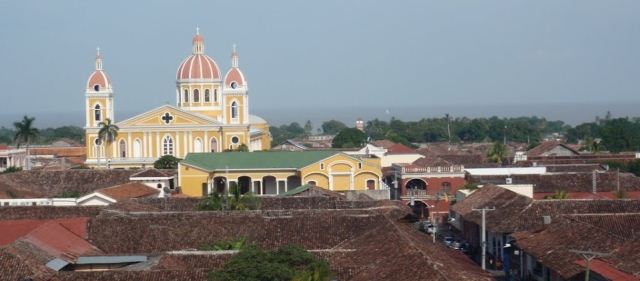
View across Granada
In a last minute effort to get out of Managua I tried to book on an organised day trip to Granada. These only really cater for groups so the price was rather prohibitive. Fortunately it transpired that the German hotel owner’s daughter was a trainee tour guide eager to practice her English.
Quickly we booked a taxi for the day and set off before I could ascertain how much training she’d actually received.
What followed was a fun day where, whilst she was quite a happy tour guide, she’d not actually visited half the places before so she translated the guide book from Spanish to a combination of German and English.
Skipping a driving tour of Managua we left town and entered Nicaragua’s first and only National Park, the Masaya Volcanic complex at Nindiri. Originally one huge volcano an eruption divided it into three smaller craters which still continuously emit noxious clouds. Atop the 2083ft summit is a wooden cross that needs replacing every few years due to the sulphuric erosion. From here you can see the surrounding lava flows and all the way from Managua to Granada and the lakes beyond. You’re only allowed to stay on the summit for 20 minutes to avoid lung damage so the visitor centre is located at the end of the lava field and shows the usual guide to how volcanoes work and some rather badly stuffed local animals.
Heading further southwest to the town of Masaya we dropped into the arts and crafts market where local artisans sell their wares but all I really needed was some new t-shirts. Despite having a limited selection in my size I came away with a couple of great ones and we headed to a stall in the town square for a quick lunch. This managed not to involve rice and beans, instead consisting of a pancake filled with fried onions and a decent local approximation of Mozzarella cheese. To drink we have ground cocoa beans stirred into a thin yogurt, which I probably wouldn’t have found if I were on my own, but turned out to be surprisingly refreshing.
Slightly further down the road was Catarina, one of the areas so-called White Towns, seeming dedicated to arts and flowers. This was a very attractive little village that was slightly marred by the number of bullet holes in the walls from when it used to be a Zapatista hide-out. The road was lined with wood and ceramic workers interspersed with flower nurseries and led to a hilltop overlooking a lake, when I finally remembered I was carrying a camera with me and to take photos.
Arriving in Granada we started at the town’s fort (Fuerte la Polvora), built by the Spanish to protect themselves from the angry slaves, who seemed mostly angry about having to build a huge fort. Just down the road was a small church that allowed visitors to climb the bell tower, giving a great view over the very low-rise town. Briefly stopping in one of only two organic cigar factories in the world they seemed confused that we didn’t really want a free cigar, with neither of us smoking, but were more interested in the tortoise scuttling about the grounds.
Just then it started to rain so we took shelter in a convent, which was very peaceful and full of palm trees and animal sculptures taken from a nearby archaeological site. As the sun started to fall we hired a small boat from Puerto Asese and chugged out amongst the many isletas on Lake Nicaragua. These small private islands are owned by rich families and are spread throughout the bay. The nearest the main water is a fort, supposedly used to guard against the repeated sackings by Captain Henry Morgan, the Welsh pirate. There is also Monkey Island. Where the monkeys live. As the sun set over Volcan Mombacho it was time to find the taxi driver and head back to the less delightful surroundings of Managua.






Hi Steve,
Looks like you had a really good time in Nicaragua from what I read, I only wanted to let you know that Catarina was never a Zapatista hideout, as the Zapatistas are exclusively Mexican, named in memory of Emiliano Zapata. Catarina, was in fact a hideout for the feared national guard when the war was at its peak. Best -J
Slightly further down the road was Catarina, one of the areas so-called White Towns, seeming dedicated to arts and flowers. This was a very attractive little village that was slightly marred by the number of bullet holes in the walls from when it used to be a Zapatista hide-out.
Ah – thanks for the correction. We were working in a lot of languages so there were probably even more mistakes